Christodoulos Kalergis
Christodoulos Kalergis (Greek: Χριστόδουλος Καλέργης, 1678-1683 –1740), also known as Christodoulos Kallergis. He is one of the few Greek painters that were not from Crete or the Ionian Islands. He was from the Cyclades. He was active on the island of Mykonos and the Peloponnese Region. He is a member of the Neo-Hellenikos Diafotismos in art and the Greek Rococo period. Emmanuel Skordilis brought the art of Crete to the Cyclades. He influenced Kalergis and other local artists. Kalergis's most notable piece is the Virgin and Child. His art resembles a mixture of late Byzantine art and the Venetian influenced maniera greca. Ten of his paintings and four frescos have survived. Around the period, another famous artist Nikolaos Kallergis shared the same last name.[1][2][3][4]
Christodoulos Kalergis | |
|---|---|
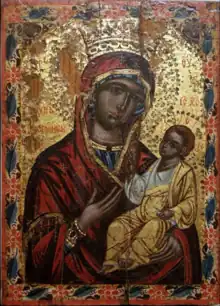 Virgin and Child | |
| Born | 1678-1683 |
| Died | 1740 |
| Nationality | Greek |
| Known for | Iconography and hagiography |
| Movement | Neo-Hellenikos Diafotismos Greek Rococo |
History
Kalergis was born on the island Mykonos. Not much is known about his life. Historians have followed the trail of signatures and dates based on frescos in different places. His first dated work was in Cynuria at the Monastery of Theotokos Artocostas around 1698. Two years later he was in Megali Vrisi, Laconia at the Church of Prodromou. In 1706, he frescoed the church of Agios Ioannis in Milia, Messenia. He frescoed the Church of Saint Nicholas in the Castle of Zarnata before 1715. It is also located in the Mani region close to Avia. By 1719, he was back on the Cyclades on the island of Serifos. The artist frescoed the Moni Taxiarchon Serifos. Some of his icons are on the islands of Amorgos, Mykonos, and Serifos. Here is one example of his signatures: διά χειρός εμού Χριστοδούλου Καλλέργη εκ νήσου Μυκόνου.[5]
Gallery
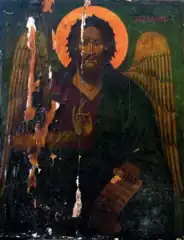 John the Baptist
John the Baptist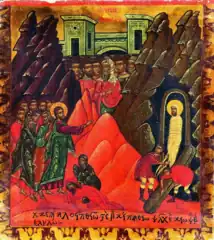 Raising of Lazarus
Raising of Lazarus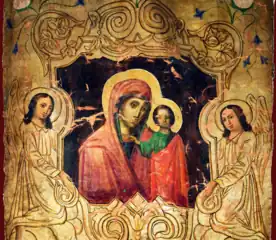 Madonna and Child
Madonna and Child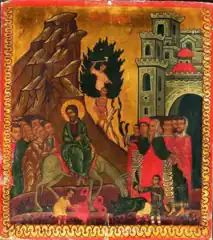 Entry into Jerusalem
Entry into Jerusalem
See also
References
- Eugenia Drakopoulou (August 15, 2021). "Χριστόδουλος Καλλέργης (Καλέργης)". Institute for Neohellenic Research. Retrieved August 15, 2021.
- Hatzidakis, Manolis & Drakopoulou, Eugenia (1997). Greek painters after the fall (1450-1830) Volume B. Athens, GR: Center for Modern Greek Studies E.I.E. pp. 56–57.
- Staff Writers (1998). The Holy and Great Monastery of Vatopaidi Tradition, History, Art · Volume 2. Mount Athos, Greece: Mount Athos Monastery. p. 341. ISBN 9789607735102.
- Anōmeritēs, Giōrgos (2013). Hē zōē kai to ergo tou hagiographou Christodoulou Kalergē "ek nēsou Mikonou". Athens, Greece: Melitos Athens. p. 15. OCLC 935390228.
- Hatzidakis, 1997, pp 56-57
Bibliography
- Hatzidakis, Manolis (1987). Greek painters after the fall (1450-1830) Volume A. Athens, GR: Center for Modern Greek Studies E.I.E.
- Hatzidakis, Manolis & Drakopoulou, Eugenia (1997). Greek painters after the fall (1450-1830) Volume B. Athens, GR: Center for Modern Greek Studies E.I.E.
- Drakopoulou, Eugenia (2010). Greek painters after the fall (1450-1830) Volume C. Athens, GR: Center for Modern Greek Studies E.I.E.